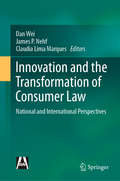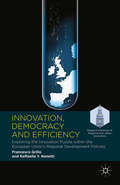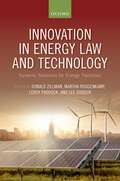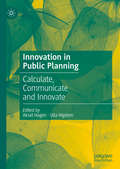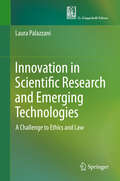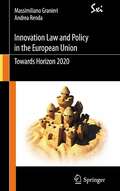- Table View
- List View
Innovation and the Transformation of Consumer Law: National and International Perspectives
by Dan Wei James P. Nehf Claudia Lima MarquesThis book covers technologies that pose new challenges for consumer policy, creative developments that can help protect consumers’ economic interests, innovative approaches to addressing perennial consumer concerns, and the challenges entailed by emerging ways of creating and delivering consumer products and services. In addition, it reflects on past successes and failures of consumer law and policy, explores opportunities for moving consumer law in a different direction, and discusses potential threats to consumer welfare, especially in connection with the changing political landscape in many parts of the world. Several chapters examine consumer law in individual countries, while others have an international focus.
Innovation, Creativity and Law (Studies in Industrial Organization #12)
by W. KingstonThis book develops the theme of my earlier Innovation: The Creative Impulse in Human Progress, and considerably expands the latter book. I came to the study of innovation from experience in industry which had brought me into close practical contact with it, and my initial interest in the subject was in terms of the way in which it expressed human creativity. Progressively, however, my focus shifted towards the laws which help or hinder creativeness in being economically fruitful. This led to the writing of The Political Economy of Innovation and the editing of Direct Protection of Innovation. In the latter work, I had the opportunity of arguing the case for specific new law to complement the Patent system, and of having that case criticised by experts. Just as the first book set economic innovation in a wider context of creativity, the present one sets the law that makes it possible in a wider context of property rights. This is because my study of intellectual property resulted in growing awareness of the incomparable past value and even greater future potential of these rights for innovation and prosperity. My intellectual debt to Douglass North is as great in this later stage as it was to Joseph Schumpeter in the earlier one, and to Christopher Dawson, by whom I had the good fortune to be taught in person, in both.
Innovation, Democracy and Efficiency: Exploring the Innovation Puzzle within the European Union’s Regional Development Policies (Palgrave Advances in Regional and Urban Economics)
by Raffaella Y. Nanetti Francesco GrilloEndogenous growth theory has significantly impacted most of the developing and developed countries, shifting priorities of industrial policies towards innovation. In line with this trend, the European Union significantly increased its budgetary allocation for R&D. However, statistical data show a weak correlation between R&D expenditure and the acceleration of economic growth. Regional innovation policies display divergent returns according to different institutional conditions and policy choices.Grillo and Nanetti attempt to understand the reasons that lie behind differences in performance. Their results show that better performing innovation strategies require the following factors: clear choices of locally congruent smart specialization; strong capacity of public investment to stimulate additional private investment; clear distribution of responsibilities for decision-making and independence of policy implementation from political interference; and problem solving partnerships amongst innovators, universities, and governments that pre-exist the programmes. These factors point to a relationship between democracy (defined as openness of policy-making) and innovation (as technology-enabled growth) which is explored throughout this book.
Innovation, Economic Development, and Intellectual Property in India and China: Comparing Six Economic Sectors (ARCIALA Series on Intellectual Assets and Law in Asia)
by Kung-Chung Liu Uday S. RacherlaThis open access book analyses intellectual property codification and innovation governance in the development of six key industries in India and China. These industries are reflective of the innovation and economic development of the two economies, or of vital importance to them: the IT Industry; the film industry; the pharmaceutical industry; plant varieties and food security; the automobile industry; and peer production and the sharing economy.The analysis extends beyond the domain of IP law, and includes economics and policy analysis. The overarching concern that cuts through all chapters is an inquiry into why certain industries have developed in one country and not in the other, including: the role that state innovation policy and/or IP policy played in such development; the nature of the state innovation policy/IP policy; and whether such policy has been causal, facilitating, crippling, co-relational, or simply irrelevant. The book asks what India and China can learn from each other, and whether there is any possibility of synergy.The book provides a real-life understanding of how IP laws interact with innovation and economic development in the six selected economic sectors in China and India. The reader can also draw lessons from the success or failure of these sectors.
Innovation, Ethics and our Common Futures: A Collaborative Philosophy
by Rafael ZieglerThe important yet contradictory role of innovation in society calls for a philosophy of innovation. Critically exploring innovation in relation to values, the economy and social change, Rafael Ziegler proposes a collaborative theory and practice of innovation that aims to liberate possibilities for our common futures. Following cues from the arts and drawing on the innovation literature across the social sciences, this book exposes pro-innovation bias and the gospel of disruptive change. Not only entrepreneurs but also civic networks and tinkerers are discussed as sources of innovation, and social change as a balancing act of innovation, exnovation and restoration. The discussion of capabilitarian, communitarian, liberal, republican and socialist ideas of justice and innovation leads Ziegler to a transformative proposal: ‘enough innovation’ based on enough for all and with respect for all. This is a thought-provoking read for scholars working on sustainability-transformation, democratic, responsible and social innovation, and philosophy of economics.
Innovation for Sustainability: Business Transformations Towards a Better World (Palgrave Studies in Sustainable Business In Association with Future Earth)
by Robert Verburg Nancy Bocken Paavo Ritala Laura AlbaredaThe aim of this edited book is to provide a comprehensive overview of the opportunities and challenges related to innovation for sustainability. Combining work from both emerging and established scholars in different academic fields, this book provides an integrated understanding of the topic from four perspectives. First, the big picture: frameworks, types, and drivers; second, strategy and leadership; third, measurement and assessment and fourth, tools, methods and technologies.Chapter 11 of this book is available open access under a CC BY 4.0 license at link.springer.com.The editors donate their remuneration for this book to conservation organisation the WWF.
Innovation for the 21st Century
by Michael A. CarrierIn recent years, innovation has been threatened by the United States legal system. Much of the blame can be attributed to the antitrust and intellectual property laws. Innovation for the 21st Century seeks to reverse this trend, offering ten revolutionary proposals, from pharmaceuticals to peer-to-peer software, to help foster innovation. Michael A. Carrier illustrates the benefits of improving the patent system and incorporating innovation into copyright and antitrust law. He also dips into a rich business literature to import ideas on "disruptive innovation" and "user innovation." And he replaces the 20th-century view that the IP and antitrust laws are in conflict with a new 21st-century framework that treats them as collaborators. Innovation for the 21st Century: Harnessing the Power of Intellectual Property and Antitrust Law provides a comprehensive framework for the patent, copyright, and antitrust laws to promote innovation.
The Innovation Handbook: How to Profit from Your Ideas, Intellectual Property and Market Knowledge
by Adam JollyIn fast-moving markets, no organization can expect to identify and keep the best ideas by working in isolation; innovation is now running on an open model, with input from a variety of disciplines and sources, including specialists, employees, suppliers and, in particular, customers and clients.But how can you stimulate new innovation? And how can you protect your best ideas once they are in a competitive and aggressive marketplace? Endorsed by the UK's Intellectual Property Office and the Technology Strategy Board, The Innovation Handbook offers advice and commentary from leading players in the technology, branding, design, intellectual property and innovation fields.
The Innovation Handbook: How to Profit from Your Ideas, Intellectual Property and Market Knowledge
by Adam JollyIn fast-moving markets, no organization can expect to identify and keep the best ideas by working in isolation; innovation is now running on an open model, with input from a variety of disciplines and sources, including specialists, employees, suppliers and, in particular, customers and clients.But how can you stimulate new innovation? And how can you protect your best ideas once they are in a competitive and aggressive marketplace? Endorsed by the UK's Intellectual Property Office and the Technology Strategy Board, The Innovation Handbook offers advice and commentary from leading players in the technology, branding, design, intellectual property and innovation fields.
Innovation in Africa: Levelling the Playing Field to Promote Technology Transfer
by Fernando dos SantosTechnology is key to the development of nations yet is not freely or easily accessible. This book aims to contribute to the debate about empowering Africa to play a more meaningful role in the global innovation system. It emphasizes the important role of technology transfer in assisting Least Developed Countries (LDCs) in Africa to expand their technological capabilities. The book surveys IP and innovation policies in Africa's past and present, providing theoretical, policy, and legal frameworks, as well as specific measures that will help African LDCs. It proposes solutions to overcome challenges currently posed by inefficiencies in the flow of technologies to LDCs and by the fragmentation of the international legal framework that regulates technology transfer. Notably, the book proposes maximal implementation of the TRIPS Agreement provisions related to technology transfer and recommends the adoption of a uniform international legal instrument under the framework of the WTO to be designated as the Agreement on Trade-Related Issues of Technology Transfer and Innovation (TRITTI). The book advocates for proactivity from African LDCs and urges them to cultivate environments that attract and enable technology transfer into their respective states. This will facilitate technological learning, accelerate absorption and adaptation fit to an African context, and will catapult African LDCs down the road of innovation.
Innovation in Africa: Levelling the Playing Field to Promote Technology Transfer
by Fernando dos SantosTechnology is key to the development of nations yet is not freely or easily accessible. This book aims to contribute to the debate about empowering Africa to play a more meaningful role in the global innovation system. It emphasizes the important role of technology transfer in assisting Least Developed Countries (LDCs) in Africa to expand their technological capabilities. The book surveys IP and innovation policies in Africa's past and present, providing theoretical, policy, and legal frameworks, as well as specific measures that will help African LDCs. It proposes solutions to overcome challenges currently posed by inefficiencies in the flow of technologies to LDCs and by the fragmentation of the international legal framework that regulates technology transfer. Notably, the book proposes maximal implementation of the TRIPS Agreement provisions related to technology transfer and recommends the adoption of a uniform international legal instrument under the framework of the WTO to be designated as the Agreement on Trade-Related Issues of Technology Transfer and Innovation (TRITTI). The book advocates for proactivity from African LDCs and urges them to cultivate environments that attract and enable technology transfer into their respective states. This will facilitate technological learning, accelerate absorption and adaptation fit to an African context, and will catapult African LDCs down the road of innovation.
Innovation in Energy Law and Technology: Dynamic Solutions for Energy Transitions
by Donald Zillman, Martha Roggenkamp, Leroy Paddock and Lee GoddenThere are few existential challenges more serious in the twenty first century than energy transition. As current trends in energy production prove unsustainable for the environment, energy security, and economic development, innovation becomes imperative. Yet, with technological challenges, come legal challenges. Zillman, Godden, Paddock, and Roggenkamp assemble a team of experts in their field to debate how the law may have to adapt to changes in the area. What regulatory approach should be used? How do we deal with longer-term investment horizons and so called 'stranded assets' such as coal-fired power stations? And can a form of energy justice be achieved which encompasses human rights, sustainable development goals, and the eradication of energy poverty? With a concept as unwieldy as energy innovation, it is high time for a text tackling changes which are dynamic and diverse across different communities, and which provides a thorough examination of the legal ramifications of the most recent technological changes. This book which be of vital importance to lawyers, policy-makers, economists, and the general reader.
Innovation in Energy Law and Technology: Dynamic Solutions for Energy Transitions
There are few existential challenges more serious in the twenty first century than energy transition. As current trends in energy production prove unsustainable for the environment, energy security, and economic development, innovation becomes imperative. Yet, with technological challenges, come legal challenges. Zillman, Godden, Paddock, and Roggenkamp assemble a team of experts in their field to debate how the law may have to adapt to changes in the area. What regulatory approach should be used? How do we deal with longer-term investment horizons and so called 'stranded assets' such as coal-fired power stations? And can a form of energy justice be achieved which encompasses human rights, sustainable development goals, and the eradication of energy poverty? With a concept as unwieldy as energy innovation, it is high time for a text tackling changes which are dynamic and diverse across different communities, and which provides a thorough examination of the legal ramifications of the most recent technological changes. This book which be of vital importance to lawyers, policy-makers, economists, and the general reader.
Innovation in Environmental Leadership: Critical Perspectives (Routledge Studies in Leadership Research)
by Benjamin W. Redekop Deborah Rigling Gallagher Rian SatterwhiteInnovation in Environmental Leadership offers innovative approaches to leadership from a post-industrial and ecological vantage point. Chapters in this collection are written by leading scholars and practitioners of environmental leadership from around the globe, and are informed by a variety of critical perspectives, including post-heroic approaches, systems thinking, and the emerging insights of Critical Leadership Studies (CLS). By taking the natural environment seriously as a foundational context for leadership, Innovation in Environmental Leadership offers fresh insights and compelling visions of leadership pertinent to 21st century environmental and social challenges. Concepts and understandings of leadership emerged as part of an extractive industrial system; this work asks its readers to re-think what leadership looks like in an ecologically sustainable biological system. This book provides fresh insights and critical perspectives on the vibrant and growing field of environmental leadership. It shows the latest state of knowledge on the topic and will be of interest both to students at an advanced level, academics and reflective practitioners. It addresses the topics with regard to leadership theory and environmental leadership and will be of interest to researchers, academics, and students in the fields of sustainability, environmental ethics, natural resource management, environmental studies, business management, public policy, and environmental management.
Innovation in Environmental Leadership: Critical Perspectives (Routledge Studies in Leadership Research)
by Benjamin W. Redekop Deborah Rigling Gallagher Rian SatterwhiteInnovation in Environmental Leadership offers innovative approaches to leadership from a post-industrial and ecological vantage point. Chapters in this collection are written by leading scholars and practitioners of environmental leadership from around the globe, and are informed by a variety of critical perspectives, including post-heroic approaches, systems thinking, and the emerging insights of Critical Leadership Studies (CLS). By taking the natural environment seriously as a foundational context for leadership, Innovation in Environmental Leadership offers fresh insights and compelling visions of leadership pertinent to 21st century environmental and social challenges. Concepts and understandings of leadership emerged as part of an extractive industrial system; this work asks its readers to re-think what leadership looks like in an ecologically sustainable biological system. This book provides fresh insights and critical perspectives on the vibrant and growing field of environmental leadership. It shows the latest state of knowledge on the topic and will be of interest both to students at an advanced level, academics and reflective practitioners. It addresses the topics with regard to leadership theory and environmental leadership and will be of interest to researchers, academics, and students in the fields of sustainability, environmental ethics, natural resource management, environmental studies, business management, public policy, and environmental management.
Innovation in Medical Technology: Ethical Issues and Challenges
by Margaret L. Eaton Donald KennedyThis thought-provoking study examines the ethical, legal, and social problems that arise with cutting-edge medical technology. Using as examples four powerful and largely unregulated technologies—off-label use of drugs, innovative surgery, assisted reproduction, and neuroimaging—Margaret L. Eaton and Donald Kennedy illustrate the difficult challenges faced by clinicians, researchers, and policy makers who seek to advance the frontiers of medicine safely and responsibly.Supported by medical history and case studies and drawing on reports from dozens of experts, the authors address important practical, ethical, and policy issues. They consider topics such as the responsible introduction of new medical products and services, the importance of patient consent, the extent of the duty to mitigate harm, and the responsibility to facilitate access to new medical therapies.This work's insights into the nature and consequences of medical innovation contribute to the national debate on how best to protect patients while fostering innovation and securing benefits.
Innovation in Public Planning: Calculate, Communicate and Innovate
by Aksel Hagen Ulla HigdemThis book contributes to the discourse on planning theory by accentuating the perspective of public innovation. Extending planning theory's traditional two major perspectives - 'Communicate' and 'Calculate' - the book argues that contemporary planning theory should incorporate 'Innovate' as a third perspective. It highlights the multitude of new perspectives that innovative planning can bring to bear on planning theory, as well as showing how the interplay between the three perspectives - 'Communicate', 'Calculate' and 'Innovate' - can help to address vital issues in contemporary societal development.
Innovation in Scientific Research and Emerging Technologies: A Challenge to Ethics and Law
by Laura PalazzaniThis book discusses the ethical and legal challenges related to innovations, with reference to both scientific research and emerging technologies. It analyzes scientific research with specific reference to experimentation, with a focus on vulnerable people (minors, women, people in developing countries), compassionate care, biobanks and ethical committees. In the context of emerging technologies, it examines the ethical and legal aspects of neuroscience, genomics, ICT, big data, biometrics, converging technologies, enhancement and robotics. The book provides conceptual tools and categories to help readers understand and acquire a critical awareness of the current debates in the field.
Innovation in the Public Sector: Linking Capacity and Leadership (Governance and Public Management)
by Victor Bekkers, Jurian Edelenbos and Bram SteijnAddresses issues relevant to an understanding of the innovation journeys on which public organizations have embarked. If public innovation is defined as a necessary condition for establishing meaningful interactions between the government and society what are the relevant issues that may explain successful processes and forms of public innovation?
Innovation, Intellectual Property, and Economic Growth
by Christine Greenhalgh Mark RogersWhat drives innovation? How does it contribute to the growth of firms, industries, and economies? And do intellectual property rights help or hurt innovation and growth? Uniquely combining microeconomics, macroeconomics, and theory with empirical analysis drawn from the United States and Europe, this book introduces graduate students and advanced undergraduates to the complex process of innovation. By addressing all the major dimensions of innovation in a single text, Christine Greenhalgh and Mark Rogers are able to show how outcomes at the microlevel feed through to the macro-outcomes that in turn determine personal incomes and job opportunities. In four sections, this textbook comprehensively addresses the nature of innovation and intellectual property, the microeconomics and macroeconomics of innovation, and economic policy at the firm and macroeconomic levels. Among the topics fully explored are the role of intellectual property in creating incentives to innovate; the social returns of innovation; the creation and destruction of jobs by innovation; whether more or fewer intellectual property rights would give firms better incentives to innovate; and the contentious issues surrounding international treaties on intellectual property. Clearly organized and highly readable, the book is designed to be accessible to readers without advanced economics backgrounds. Most technical materials appear in boxed inserts and appendixes, and numerous graphs and tables elucidate abstract concepts. Provides a comprehensive overview of the economic causes and effects of innovation Covers microeconomics, macroeconomics, theoretical and empirical analysis, and policy Includes up-to-date coverage of trends and policy in intellectual property and research and development Features mathematics appendix and keywords and questions to assist learning and teaching Outline lecture slides are available online
Innovation, Intellectual Property, and Economic Growth
by Christine Greenhalgh Mark RogersWhat drives innovation? How does it contribute to the growth of firms, industries, and economies? And do intellectual property rights help or hurt innovation and growth? Uniquely combining microeconomics, macroeconomics, and theory with empirical analysis drawn from the United States and Europe, this book introduces graduate students and advanced undergraduates to the complex process of innovation. By addressing all the major dimensions of innovation in a single text, Christine Greenhalgh and Mark Rogers are able to show how outcomes at the microlevel feed through to the macro-outcomes that in turn determine personal incomes and job opportunities. In four sections, this textbook comprehensively addresses the nature of innovation and intellectual property, the microeconomics and macroeconomics of innovation, and economic policy at the firm and macroeconomic levels. Among the topics fully explored are the role of intellectual property in creating incentives to innovate; the social returns of innovation; the creation and destruction of jobs by innovation; whether more or fewer intellectual property rights would give firms better incentives to innovate; and the contentious issues surrounding international treaties on intellectual property. Clearly organized and highly readable, the book is designed to be accessible to readers without advanced economics backgrounds. Most technical materials appear in boxed inserts and appendixes, and numerous graphs and tables elucidate abstract concepts. Provides a comprehensive overview of the economic causes and effects of innovation Covers microeconomics, macroeconomics, theoretical and empirical analysis, and policy Includes up-to-date coverage of trends and policy in intellectual property and research and development Features mathematics appendix and keywords and questions to assist learning and teaching Outline lecture slides are available online
Innovation, Intellectual Property, and Economic Growth
by Christine Greenhalgh Mark RogersWhat drives innovation? How does it contribute to the growth of firms, industries, and economies? And do intellectual property rights help or hurt innovation and growth? Uniquely combining microeconomics, macroeconomics, and theory with empirical analysis drawn from the United States and Europe, this book introduces graduate students and advanced undergraduates to the complex process of innovation. By addressing all the major dimensions of innovation in a single text, Christine Greenhalgh and Mark Rogers are able to show how outcomes at the microlevel feed through to the macro-outcomes that in turn determine personal incomes and job opportunities. In four sections, this textbook comprehensively addresses the nature of innovation and intellectual property, the microeconomics and macroeconomics of innovation, and economic policy at the firm and macroeconomic levels. Among the topics fully explored are the role of intellectual property in creating incentives to innovate; the social returns of innovation; the creation and destruction of jobs by innovation; whether more or fewer intellectual property rights would give firms better incentives to innovate; and the contentious issues surrounding international treaties on intellectual property. Clearly organized and highly readable, the book is designed to be accessible to readers without advanced economics backgrounds. Most technical materials appear in boxed inserts and appendixes, and numerous graphs and tables elucidate abstract concepts. Provides a comprehensive overview of the economic causes and effects of innovation Covers microeconomics, macroeconomics, theoretical and empirical analysis, and policy Includes up-to-date coverage of trends and policy in intellectual property and research and development Features mathematics appendix and keywords and questions to assist learning and teaching Outline lecture slides are available online
Innovation Law and Policy in the European Union: Towards Horizon 2020 (SxI - Springer for Innovation / SxI - Springer per l'Innovazione)
by Massimiliano Granieri Andrea RendaThe book provides a critical overview of innovation policy in Europe and a synopsis of the current institutional framework of Europe shaped after the Europe2020 strategy and in view of the upcoming Horizon2020 agenda. What emerges is a rather gloomy outlook for the future of Europe's innovation, unless EU institutions and Member States will decide to streamline existing policies and build a "layered" model of innovation, in which governments act as investors in key enabling infrastructure such as ICT and education; as enablers of large technology markets where researchers and entrepreneurs can meet; and as purchasers of innovation when key societal challenges are at stake. The book contains proposals for the future innovation strategy of the EU and a specific analysis of areas such as the unitary patent, the transfer of technology (particularly as far as climate-related technologies and IP markets are concerned), standardization, and the digital agenda.
Innovation Management and Corporate Social Responsibility: Social Responsibility as Competitive Advantage (PDF) (CSR, Sustainability, Ethics & Governance)
by Editor Reinhard AltenburgerThis book provides readers with in-depth insights into Corporate Social Responsibility (CSR) and sustainability strategies, as well as their impacts on product and process innovation, business models and social innovation around the globe. It explains how resource issues, climate change, the impacts of pollution and economic activities, and emerging social challenges inevitably lead to changes in the business environment, cost structure and competitive advantage. Further, it highlights how these changes influence the process of innovation, and how companies can gain an edge by integrating stakeholder groups in their innovation process, and by considering sustainability and the needs of society at large. The book reflects the immense strides made in recent years in the discussion about the relationship between business and society, and demonstrates the increasing impact on innovation management.
Innovation Management and Corporate Social Responsibility: Social Responsibility as Competitive Advantage (CSR, Sustainability, Ethics & Governance)
by Reinhard AltenburgerThis book provides readers with in-depth insights into Corporate Social Responsibility (CSR) and sustainability strategies, as well as their impacts on product and process innovation, business models and social innovation around the globe. It explains how resource issues, climate change, the impacts of pollution and economic activities, and emerging social challenges inevitably lead to changes in the business environment, cost structure and competitive advantage. Further, it highlights how these changes influence the process of innovation, and how companies can gain an edge by integrating stakeholder groups in their innovation process, and by considering sustainability and the needs of society at large. The book reflects the immense strides made in recent years in the discussion about the relationship between business and society, and demonstrates the increasing impact on innovation management.
